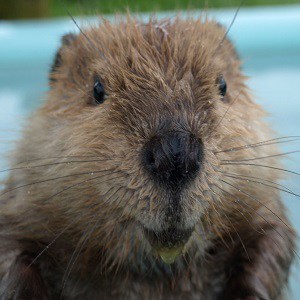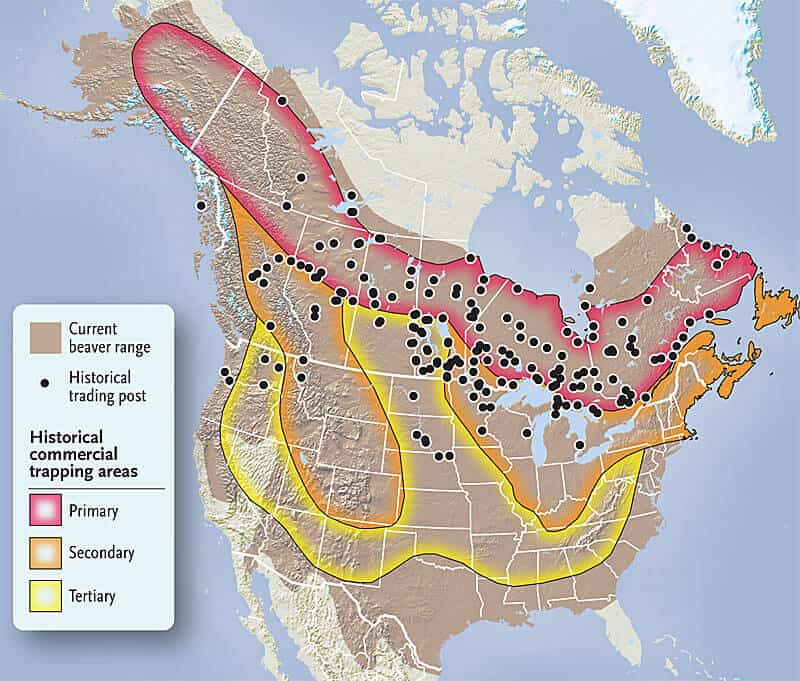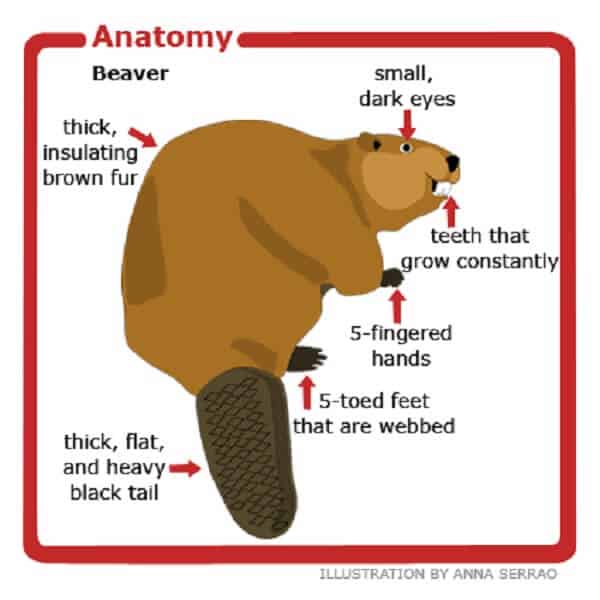Beavers Are Sociable, Except When They Work
Beavers are very sociable animals. They live in large family groups called colonies. Each family group will typically consist of monogamous parents, their new young kits, and their yearlings that were born the previous spring. Young beavers stay with their parents for approximately two years, helping them to maintain their lodge and dam. Although beavers are generally sociable animals, the exception to this is when they work. Beavers work independently and tend to have little contact with each other while working.
Beavers’ Bodies Are Designed for a Semi-Aquatic Lifestyle
Beavers divide their time between land and water. Therefore, their bodies are specially designed to help them cope with this semi-aquatic lifestyle. They are able to move efficiently through the water thanks to their stiff tails and webbed feet. In addition, their thick fur acts as a waterproof coating that keeps out the cold when they’re swimming. Talk about having the best of both worlds!
Beaver Lodges Are Built in Open Water
Beaver homes are referred to as lodges. These structures are domelike in shape and are made from mud and branches. In order to protect themselves from predators, beavers build their lodges in open water. For further protection, these lodges also have underwater entrances.
Beavers Are House Proud and Hospitable Hosts
One of the most endearing beaver facts is that these animals are actually quite house proud. Their lodges typically consist of two rooms. The first room is used by the beavers for drying off after using the underwater entrance. The second, drier, room is where the beaver family lives and socializes. One of the lesser known beaver facts is that these animals are sometimes very hospitable hosts. Beaver families have been observed sharing their lodges with families of muskrats. And you don’t get more hospitable than that!
Beavers’ Teeth Never Stop Growing
As you might expect from a rodent, a beaver’s teeth are quite large. One of the most intriguing beaver facts is that their teeth never stop growing. This is why beavers are constantly observed gnawing on wood: the continuous gnawing helps to wear down their teeth and prevent them from growing too long.
Beavers Use Their Tails to Steer, Balance, and Warn Others
Beavers use their foot-long tails for several different purposes. Their wide stiff tails make effective rudders to steer beavers as they swim in the water. Their tails are just as useful on land, too, helping beavers to balance. Beavers also use their tails as levers to help them drag branches. In addition, beavers will slap their tails on the water surface, with the noise acting as a warning signal to either warn others of danger or as a warning to keep away. It’s like having a Swiss Army Tail!
Beavers Hiss When Frightened
We have already established that beavers slap their tails on the water surface when they sense danger. If they are frightened, beavers also tend to make a hissing sound. If a beaver is hissing, it’s best to keep your distance! You don’t want to have an encounter with those large, long, sharp rodent teeth…
Beavers Don’t Feel the Cold
Unlike many other animals, beavers remain active throughout the colder winter months. In fact, they continue to use their ponds, even when they are covered in a layer of ice. They are able to do this because their bodies are specially adapted to help them withstand freezing cold water. It’s as though they’re born wearing their own furry wetsuit!
Beavers Can See Underwater
One of the most fascinating beaver facts is that beavers can see underwater. Beavers have three sets of eyelids. The third is a set transparent eyelids that enable them to close their eyes yet retain their vision whilst underwater. Imagine having built in goggles for your eyes! Despite this, beavers actually have quite poor eyesight. However, they make up for this with excellent hearing and a highly developed sense of smell.
Beavers Can Hold Their Breath for 15 Minutes Underwater
The behavior of beavers means that they need to be able to remain underwater for several minutes at a time. Because beavers are unable to breathe underwater, they have to hold their breath. Incredibly, these creatures can hold their breath underwater for up to 15 minutes at a time.
Beavers Fell Different Trees for Different Reasons
A list of beaver facts for kids wouldn’t be complete without an explanation of the different trees that are felled by beavers. Beavers will fell larger, more mature trees to form the solid base of a dam. Younger, second growth trees are felled to provide the beavers with food. Beavers will fell broad leaf trees in order to encourage re-growth, so that more food grows within their reach.
Beavers Encourage Growth of the Plants That They Eat
Beavers are herbivores. They eat tree bark from several species, such as maple, aspen and cherry trees. They also feed on different types of leaves, water lilies, and pond weed. Beavers actually stimulate the growth of wooden plants by pruning back the bark as they feed.
Beavers Fell Trees without Wasting
When it comes to conservation, beavers set a fine example by felling trees without wasting any part of the tree. First, they systematically eat the bark and buds of the tree. Thereafter, they cut the tree’s trunk and branches into sections to use in the construction of their dams and lodges.
Considerate Beavers Create Habitats for Other Species
One of the most fascinating beaver facts is that beavers create and maintain habitats that are used by other species. The work that beavers carry out makes them an integral species in this regard. Beavers’ dams help to create wetlands. In addition, by drowning some trees in the process, beavers also create standing dead wood. This creates a habitat for insects, which in turn attracts birdlife to the area.
Beavers’ Dams Both Cause and Prevent Floods
As we have already learnt, beavers create dams that flood certain areas, causing wetlands. These wetlands are vitally important because they soak up floodwaters. The wetlands that the beavers create are also of importance because they prevent erosion and create an ecosystem that breaks down pesticides.
Beavers Cause $100 Million Damage Every Year
It is estimated that beavers cause $100 million worth of damage every year in the United States alone. This sum is predominantly made up of property costs that are incurred as a result of their behavior. Makes you think twice about building in their natural habitat, doesn’t it?
The Largest Beaver Dam Is Visible from Space
Beavers can manipulate their environment quite dramatically, redesigning it to suit their needs by building dams, canals and lodges. In fact, they are second only to people in terms of this ability. The largest dam that has been built by beavers can be found in Wood Buffalo National Park, Alberta, Canada. This dam reaches an amazing 2,790 feet, or 850 meters, in length. It is so big that it is actually visible from space.
Beavers Were Extinct in the UK but Aren’t Any Longer
There are several beaver facts relating to conservation. One of these is that the Great British beaver was extinct in the United Kingdom for 400 years. However, in 2009 this species was re-introduced to Scotland. Then, midway through 2010, the first offspring to be born in the wild were spotted in Argyll, Scotland.
The Beaver Population in North America Has Declined Drastically
One of the more concerning beaver facts is that the beaver population in North America declined drastically in the 20th century. After European immigrants colonized North America, the beaver population dropped from 60 million to just 6 to 12 million animals. The decrease in the beaver population was principally due to hunting and loss of their natural habitat.
Beaver Tail Was a Delicacy in Canada
According to local folklore, beaver tail was considered to be a delicacy by mountain hunters in Canada. When President Barack Obama, the president of the United States, made a visit to Ottawa he in fact ate a beaver tail – but his was made from whole-wheat dough!
Beaver Facts – Facts about Beavers Summary

Beaver Facts



No comments:
Post a Comment